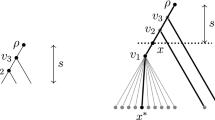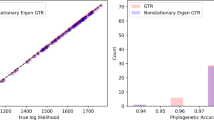Abstract
This manuscript extends the work of Spade et al. (Math Biosci 268:9–21, 2015) to an examination of a fully-updating version of a Metropolis-Hastings algorithm for inference of phylogenetic branch lengths. This approach serves as an intermediary between theoretical assessment of Markov chain convergence, which in phylogenetic settings is typically difficult to do analytically, and output-based convergence diagnostics, which suffer from several of their own limitations. In this manuscript, we will also examine the performance of the convergence assessment techniques for this Markov chain and the convergence behavior of this type of Markov chain compared to the one-at-a-time updating scheme investigated in Spade et al. (Math Biosci 268:9–21, 2015). We will also vary the choices of the drift function in order to obtain a sense of how the choice of the drift function affects the estimated bound on the chain’s mixing time.






Similar content being viewed by others
References
Allman E, Ané C, Rhodes J (2008) Identifiability of a markovian model of molecular evolution with gamma-distributed rates. Adv Appl Probab 40:229–249
Binet M, Gascuel O, Scornavacca C, Douzery EJP, Pardi F (2016) Fast and accurate branch lengths estimation for phylogenomic trees. BMC Bioinform 17:23–40
Bryant D, Waddell P (1998) Rapid evaluation of least-squares and minimum-evolution criteria on phylogenetic trees. Mol Biol Evol 15:1346–1359
Camin JH, Sokal RR (1965) A method for deducing branching sequences in phylogeny. Evolution 19:311–326
Cavalli-Sforza LL, Edwards AWF (1965) Analysis of human evolution. In: Genetics today, proceedings of the XI international congress of genetics, The Hague, Netherlands
Cavalli-Svorza LL, Edwards AWF (1967) Phylogenetic analysis: models and estimation procedures. Am J Hum Genet 19:233–257
Chib S, Nardari F, Shephard N (1998) Markov chain monte carlo methods for generalized stochastic volatility models. J Econom 108:281–316
Cowles MK, Carlin BP (1996) Markov chain monte carlo convergence diagnostics: a comparative review. J Am Stat Assoc 91:883–904
Cowles MK, Rosenthal JS (1998) A simulation-based approach to convergence rates for markov chain monte carlo algorithms. Stat Comput 8:115–124
Drummond AJ, Suchard MA, Xie D, Rambaut A (2012) Bayesian phylogenetics with BEAUti and the BEAST 17. Molecul Biol Evol 29(8):1969–1973
Eck RV, Dayhoff MO (1966) Atlas of protein sequence and structure. National Biomedical Research Foundation, Silver Spring
Edwards AWF, Cavalli-Sforza LL (1964) Reconstruction of evolutionary trees. Phen Phylogen Classif, pp 67–76
Edwards AWF (1970) Estimation of the branch points of a branching diffusion process. J Roy Stat Soc B 32:155–174
Felsenstein J (1981) Evolutionary trees from DNA sequences: a maximum likelihood approach. J Mol Evol 17:368–376
Fitch WM, Margoliash E (1967) Construction of phylogenetic trees. Science 155:279–284
Fort G, Moulines G, Roberts GO, Rosenthal JS (2003) On the geometric ergodicity of hybrid samplers. J Appl Probab 40:123–146
Gelman A, Rubin DB (1992) Inference from iterative simulation using multiple sequences. Stat Sci 7:457–511
Gelman A, Roberts GO, Gilks WR (1996) Efficient metropolis jumping rules. Bayesian. Stat 5:599–607
Geweke J (1992) Evaluating the accuracy of sampling-based approaches to calculating posterior moments. In: Bernardo JM, Berger J, Dawid AP, Smith AFM (eds) Bayesian statistics 4. Oxford University Press, Oxford
Harper CW (1979) A Bayesian probability view of phylogenetic systematics. Syst Zool 28:547–553
Hastings W (1970) Monte Carlo sampling techniques using markov chains and their applications. Biometrika 57:97–109
Heidelberger P, Welch PD (1983) Simulation run length control in the presence of an initial transient. Oper Res 31:1109–1144
Huelsenbeck JP, Ronquist F (2001) MRBAYES: Bayesian inference of phylogeny. Bioinformatics 17:754–755
Ishwaran H, James LF, Sun J (2001) Bayesian model selection and finite mixtures by marginal density decompositions. J Am Stat Assoc 96:1316–1332
Jarner SF, Hansen E (2000) Geometric ergodicity of metropolis algorithms. Stoch Process Appl 85:341–361
Jones G, Hobert JP (2001) Honest exploration of intractable probability distributions via markov chain monte carlo. Stat Sci 16(4):312–334
Jukes T, Cantor C (1969) Evolution of protein molecules. Mammalian protein metabolism, vol III. Academic Press, New York, pp 21–32
Kluge AG, Farris JS (1969) Phyletics and the evolution of anurans. Syst Zool 18:1–32
Li H, Homer N (2010) A survey of sequence alignment algorithms for next-generation sequencing. Brief Bioinform 11:473–483
Li S, Pearl DK, Doss H (2000) Phylogenetic tree construction using markov chain monte carlo. J Am Stat Assoc 95:493–508
Liang F (2007) Continuous contour monte carlo for marginal density estimation with an application to a spatial statistical model. J Comput Graph Stat 16(3):608–632
Madras N, Sezer D (2010) Quantitative bounds for markov chain convergence: wasserstein and total variation distances. Bernoulli 16(3):882–908
Mau B, Newton MA (1997) Phylogenetic inference for binary data on dendograms using markov chain monte carlo. J Comput Graph Stat 6:122–131
Mengersen KL, Tweedie RL (1996) Rates of convergence of the hastings and metropolis algorithms. Ann Stat 24(1):101–121
Metropolis N, Rosenbluth A, Rosenbluth M, Teller A, Teller E (1953) Equations of state calculations by fast computing machines. J Chem Phys 21:1087–1092
Neal RM (1998) Annealed importance sampling. Technical report, University of Toronto Department of Statistics
Needleman SB, Wunsch CD (1970) A general method applicable to the search for similarities in the amino acid sequence of two proteins. J Mol Biol 48(3):443–453
Oh M, Berger JO (1989) Adaptive importance sampling in monte carlo integration. Techincal report, Purdue University Department of Statistics
Rannala B, Zhu T, Yang Z (2012) Tail paradox, partial identifiability, and influential priors in bayesian branch length inference. Mol Biol Evol 29(1):325–335
Redelings BD, Suchard MA (2005) Joint Bayesian estimation of alignment and phylogeny. Syst Biol 54(3):401–418
Roberts GO, Tweedie RL (1996) Geometric convergence and central limit theorems for multidimensional hastings and metropolis algorithms. Biometrika 83(1):95–110
Ronquist F, Teslenko M, van der Mark P, Ayres DL, Darling A, Hohna S, Larget B, Liu L, Suchard MA, Huelsenbeck JP (2012) MrBayes 32: efficient bayesian phylogenetic inference and model choice across a large model space. Syst Biol 61(3):539–542
Rosenthal JS (1995) Minorization conditions and convergence rates for markov chain monte carlo. J Am Stat Assoc 90:558–566
Sankoff D (1972) Matching sequences under insertion-deletion constraints. Proc Nat Acad Sci USA 66:4–6
Spade DA (2016) A computational procedure for efficient estimation of the convergence rate of the random-scan metropolis algorithm. Stat Comput 26(4):745–760
Spade DA, Herbei R, Kubatko LS (2015) Geometric ergodicity of a hybrid sampler for bayesian inference of phylogenetic branch lengths. Math Biosci 268:9–21
Steel M, Hein JJ (2001) A generalization of the thorne-kishino-felsenstein model for statistical alignment to k sequences related by a star tree. Lett Appl Math 14:679–684
Tamura K, Nei M (1993) Estimation of the number of nucleotide substitutions in the control region of mitochondrial dna in humans and chimpanzees. Mol Biol Evol 10:612–626
Tavare S (1986) Some probabilistic and statistical problems in the analysis of DNA sequences. In: Lectures on mathematics in the life sciences. American Mathematical Society, pp 57–86
Thompson KL, Kubatko LS (2013) Using ancestral information to detect and localize quantitative trait loci in genome-wide association studies. BMC Bioinform 14:200
Yang Z, Rannala B (1997) Bayesian phylogenetic inference using DNA sequences: a markov chain monte carlo approach. Mol Biol Evol 14:717–724
Yu B, Mykland P (1994) Looking at markov samplers through CUSUM path plots: a simple diagnostic idea. Technical report 413, University of California at Berkeley Department of Statistics
Zander R (2001) A conditional probability of reconstruction measure for internal cladogram branches. Syst Biol 50:425–437
Author information
Authors and Affiliations
Corresponding author
Additional information
Publisher's Note
Springer Nature remains neutral with regard to jurisdictional claims in published maps and institutional affiliations.
This work has been supported in part by National Science Foundation Grant NSF-DMS-1228244.
Rights and permissions
About this article
Cite this article
Spade, D.A. Geometric ergodicity of a Metropolis-Hastings algorithm for Bayesian inference of phylogenetic branch lengths. Comput Stat 35, 2043–2076 (2020). https://doi.org/10.1007/s00180-020-00969-1
Received:
Accepted:
Published:
Issue Date:
DOI: https://doi.org/10.1007/s00180-020-00969-1




